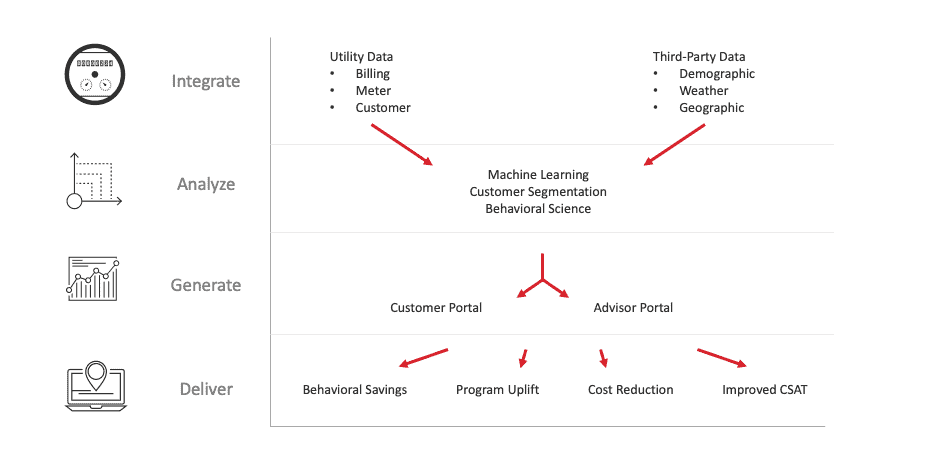Utilities can maximize their smart meter investments by connecting energy data to progressive customer actions. Doing so will enable energy providers to better engage both business and residential customer stakeholders, streamline the customer journey, and increase program adoption.
Over the last decade utilities in North America have invested heavily in AMI, with more than half of eclectic meters in North America now producing interval data. State commissions approved these AMI deployments based largely on three broad benefits: grid-stability, reduced metering costs, and improved customer service. The first two benefits have been largely realized, the last, however, has a long way to go.
From a utility perspective, digital engagement has never been more important. Customers are used to a high level of personalized service, similar to what they receive from technology leaders in the banking and software industries. Many energy providers, however, struggle to replicate these modern digital experiences.
From a consumer perspective, energy management has become much more complex in recent years. New technologies like self-generation, EV charging, and time-varying rates have reached mainstream proliferation, and many customers struggle to understand how a change would impact their costs. These new technologies are also being promoted alongside existing energy efficiency and demand response programs, resulting in an overwhelming and difficult to navigate customer experience.
How can utilities modernize the digital customer experience?
AMI data can play a big role in modernizing the business customer experience. Currently, few utilities have connected meter data to the programs, products, and services they offer.
Energy providers are engaging the wrong people
Within the business customer segment, many utility customers are still passive consumers; they pay a monthly bill and little more. The goal for utilities, however, should be to nurture and expand upon these relationships, transforming their position as a “background” vendor into that of a strategic partner.
Each stage of the journey represents a progressive energy action that is mutually beneficial for both the utility and the consumer. In an ideal world each business account would follow a similar path. Unfortunately, many energy providers have struggled to move past the first step – digital self-service. The reason for that is simple, utilities are engaging the wrong people… at least in the non-residential sector.
Most energy providers now have an online portal for bill pay, FAQ, outage, etc. which provides an excellent entry point to digital relationships. In the non-residential segment, however, the people paying the bill are often in the accounts payable department, and hence not the energy decision-maker. Additionally, the highly segmented needs of business customers create another layer of complexity. A neighborhood grocery store, for example, will have different energy stakeholders with different energy needs than a large manufacturer, or a nail salon.
To improve the customer journey, utilities need to engage broader groups of energy stakeholders within business accounts, while simultaneously serving the needs of SMBs through large industrials.
Energy providers aren’t promoting the right actions
Once the correct stakeholders are engaged there are two additional problems that diminish the current customer experience. First, an overabundance of options confuses and overwhelms time strapped customers. Second, the options that are available are generic, meaning that possible benefits are not tied to real-world data from the account.
To get a sense of just how many options utilities present to their customers take a moment and look at the website for your local energy provider. There’s likely a dropdown menu listing dozens of energy management options, often including:
- Time-Varying Rates
- Energy Efficiency Programs
- Rebates
- Incentives
- Behavioral Cost Reduction Tips
- Demand Response
- EV Charging
- Solar + Battery Storage
- Etc.
Each of these programs / services are important to the utility, but they may or may not be relevant to the individual customer. The owner of a small nail salon, for example, likely isn’t interested in fleet electrification. They may, however, be interested in behavioral cost reduction tips. As it stands today, utilities have positioned the website as the main self-service channel for discovering energy management programs, but relevant information is often buried a dozen clicks deep.
If a customer does find the page for an option they’re interested in pursuing such as time-varying rates, that page would only list generic information about the potential benefits of a rate change. What the customer actually wants is a personalized estimate of “how this rate would impact your bill”. The same experience holds true across all of the options the utility is promoting.
Generic information creates tension with the customers that are used to “suggested for you” options on Amazon and Netflix, among a host of other services. In the mind of the consumer, the utility already collects all of their usage and demand information, so why can’t potential benefits be illustrated in a personalized way? Why can’t the utility say “based on your usage/demand you could potentially save XYZ dollars each period”?
Energy providers can improve the customer experience and maximize AMI investments
AMI data can solve these issues.
If the goal is to engage stakeholders outside of accounts payable, the digital experience has to expand beyond just transactional bill payment. To do so, MyAccount needs to transform into a tool that provides benefits to facility managers, engineers, operations professionals, and other energy decision makers.
By leveraging AMI data combined with facility information, rate-codes, and firmographic data, utilities can deliver the information these stakeholders need. Visualizations for historic usage, demand, and cost data, peer comparisons, peak shift modeling, etc. would all enhance engagement with the people that make energy decisions for business accounts.

AMI can also transform the way utilities promote services to these individuals. By bundling suggestions for programs, products, and services based on the unique profile of the individual account, energy providers can remove friction from the customer journey, streamlining the options presented to each customer.
Finally, by connecting account-level data to utility offerings, energy providers can provide personalized insights into the impact that actions would have on a customer’s bill. Best rate analysis technology can model various rate options based on a customer’s historic usage and demand, delivering a highly personalized and impactful demonstration of benefits. The same estimates can be applied to DSM programs, or to DER and EV charging installations.
It’s time utilities tied AMI investments to the business customer experience
As the energy landscape continues to evolve customers will inevitably begin demanding a better digital experience. By tying meter data to customer actions, utilities can exceed these expectations and reposition themselves as a trusted partner to the business customers they serve.
To do so, utilities need to rethink the way they use AMI data and reimagine the way they engage customers, promote services, and display benefits.





